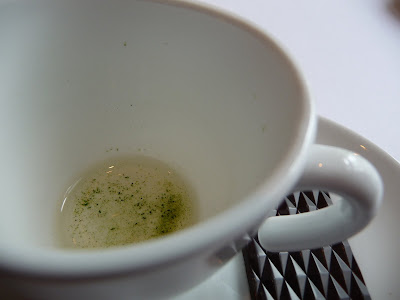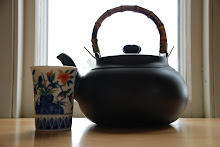
My first cup of gyokuro. My expectation was such that I felt the mysteries of Elysium would be revealed to me once I had a taste of this most prized of Japanese green teas.
It took place at the Green Teaist, a tearoom in tony Lake Forest, a suburb of Chicago. Nestled between downtown boutiques, the tea salon was a study in elegant minimalism. Moss green walls surrounded me as I leaned back on linen-covered cushions of the wooden bench. Uncluttered by requisite Victorian-themed doodads, a staple in many teahouses, the red lacquer of tabletops and light wood finish of the floor presented pleasing geometric lines that was offset by the soft sheerness of white curtains decorously shielding parked cars outside from view.
We scanned the list of teas on the menu, all Japanese greens: bancha, hojicha, sencha, the rare shincha and tencha, genmaicha, and of course, gyokuro; I felt I was in Japanese green tea heaven. I already knew what I would choose and ordered a pot of gyokuro along with a mouth watering trio of pastries. Our server brought out the tea and proffered the dry leaves to us for inspection. The deep pine-green of the leaves was striking in appearance as I inhaled. This hue is due to the unique way in which gyokuro is grown. Unlike other green teas, the tea plants used to make gyokuro are shaded from the sun for three weeks each spring before they are eventually hand-plucked. Underneath a cover of black cloth, very little sun filters through and the tea grows mostly in the dark, allowing the chlorophyll content to increase and thus imparting that rich green color characteristic of gyokuro. The famed region of Uji, south of Kyoto, is known for growing this tea and we were told that indeed this was the provenance of the tea we were about to taste.
As I ponder this, our server expertly brewed the tea. With filtered water that was cooled to the right temperature, he poured it over the leaves in the small glass teapot. The dark green leaves unfurled and yielded a golden yellow liquor.

I sipped the tea in a demitasse cup and tasted an unexpected sweetness that I had not associated with Japanese green tea. Even matcha, made from shade-grown tea leaves as well, can be a little astringent. But here, the vegetal sweetness felt buoyant, accentuated by mindful sips from the diminutive cup which served the tea so well.
The miniature piece of matcha pound cake was buttery flaky and seemed to melt in my mouth. The riot of sensations: the umami of the gyokuro and the sweet richness of the cake seemed to coax from me a sense of well-being.






7 comments:
uji gyokuro is my absolute favorite tea, for all those very reasons- especially that gentle, sweet, round grassy flavor that positively seeps into your body with one sip.
i'm so glad you got to try it, and in such a lovely spot, too.
and keep in mind that while it's amazing with food, do try it on its own sometime. when there's no other palate distractions, it really sings.
Yes, that is a good suggestion. If only the sweets did not beckon so much!
What a beautiful tea room that sounds like. I also love gyokuro... have run out though and will have to get some more. A truly delectable tea!
Ver-Tea,
I couldn't have asked for a more exquisite place to have gyokuro. But it makes sense to get my own cache to make some at home as these pots of tea there can get quite expensive!
Thank you for sharing this tea-licious Valentine!
Are you a convert yet, Arachne? :)
I am also a gyokuro fan! Love your story and blog.
Post a Comment